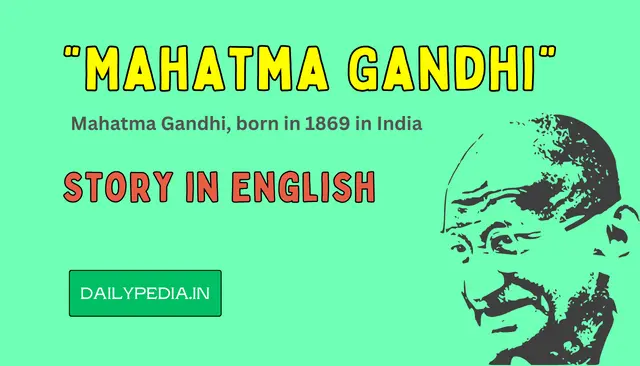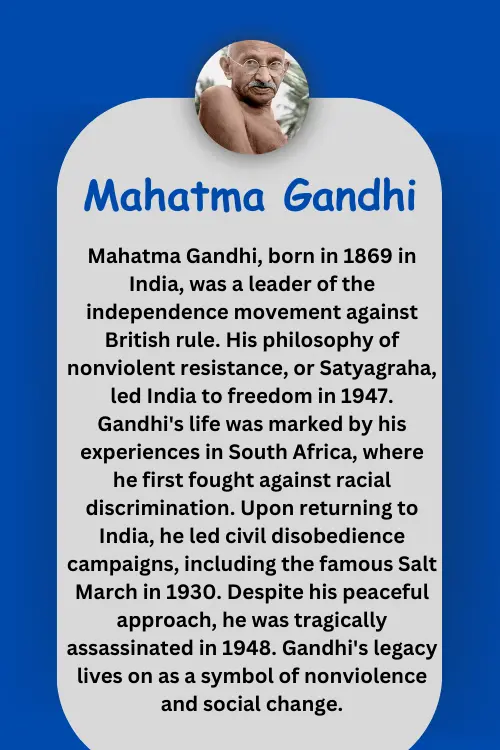Mahatma Gandhi, born in 1869 in India, was a leader of the independence movement against British rule. His philosophy of nonviolent resistance, or Satyagraha, led India to freedom in 1947. Gandhi’s life was marked by his experiences in South Africa, where he first fought against racial discrimination. Upon returning to India, he led civil disobedience campaigns, including the famous Salt March in 1930. Despite his peaceful approach, he was tragically assassinated in 1948. Gandhi’s legacy lives on as a symbol of nonviolence and social change.
Mahatma Gandhi Story in English

Mahatma Gandhi, whose full name was Mohandas Karamchand Gandhi, was a prominent leader of the Indian independence movement against British colonial rule. He is often referred to as the “Father of the Nation” in India and is celebrated worldwide for his philosophy of nonviolent resistance, which he called “Satyagraha.” Here is the story of Mahatma Gandhi in English:
Mahatma Gandhi Early Life:
Mohandas Gandhi was born on October 2, 1869, in Porbandar, a coastal town in the western part of British-ruled India (now in the Indian state of Gujarat). He was born into a Hindu family of the Vaishya (trading) caste. His father, Karamchand Gandhi, was the diwan (chief minister) of Porbandar, and his mother, Putlibai, was a deeply religious woman. Gandhi was raised in a modest and devout household.
Mahatma Gandhi Education:
Gandhi’s early education took place in Porbandar and later in Rajkot. He was an average student but showed a strong inclination toward truthfulness and nonviolence from a young age. In 1888, he traveled to London to study law, where he faced many challenges but managed to qualify as a barrister.
Mahatma Gandhi South Africa:
After completing his studies, Gandhi moved to South Africa in 1893 to work as a lawyer. It was in South Africa that he first experienced racial discrimination and injustice. These experiences transformed him into a social and political activist. He started using nonviolent resistance as a tool for social change, and his philosophy of Satyagraha began to take shape.
Mahatma Gandhi’s Return to India:
In 1915, Gandhi returned to India with a newfound commitment to fight for India’s independence from British colonial rule. He soon became a prominent leader in the Indian National Congress, which was at the forefront of the freedom struggle.
Mahatma Gandhi Nonviolent Resistance:
Gandhi’s philosophy of nonviolent resistance or Satyagraha was based on the principles of truth, nonviolence, and civil disobedience. He believed that these principles could be used to challenge oppression and injustice without resorting to violence. His first major campaign in India was against the oppressive Rowlatt Act in 1919, which allowed for the arrest and detention of Indians without trial.
Mahatma Gandhi Salt March:
One of the most iconic events in Gandhi’s life was the Salt March, also known as the Dandi March, in 1930. In protest against the British monopoly on salt, Gandhi and a group of followers marched over 240 miles to the Arabian Sea, where they made their own salt by evaporating seawater. This act of civil disobedience galvanized the Indian masses and drew international attention to the cause of Indian independence.
Mahatma Gandhi Independence and Partition:
Gandhi’s tireless efforts and commitment to nonviolence played a pivotal role in India gaining independence from British rule in 1947. However, the struggle for freedom was accompanied by communal tensions, leading to the partition of India into two separate nations, India and Pakistan.
Mahatma Gandhi Assassination:
On January 30, 1948, Mahatma Gandhi was assassinated in New Delhi by Nathuram Godse, a Hindu nationalist who disagreed with Gandhi’s views on nonviolence and religious tolerance. His death was a tragic loss to the world, but his legacy of nonviolence and his principles of truth and justice continue to inspire people worldwide.
Mahatma Gandhi’s life and teachings continue to be a source of inspiration for individuals and movements advocating for peace, justice, and human rights around the globe. He remains a symbol of the power of nonviolence in the pursuit of social and political change.
Mahatma Gandhi Story with Pictures
